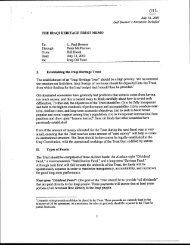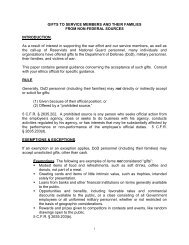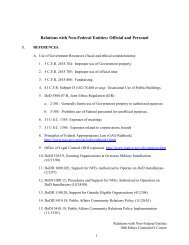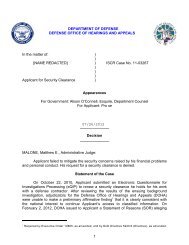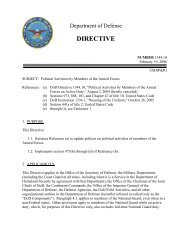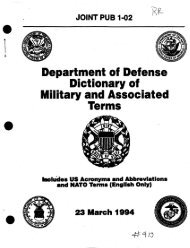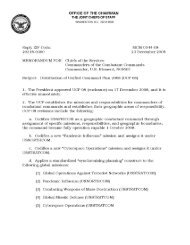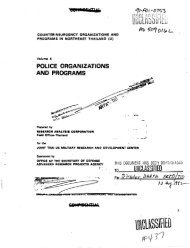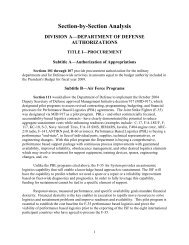dod tactical herbicide sites - United States Department of Defense
dod tactical herbicide sites - United States Department of Defense
dod tactical herbicide sites - United States Department of Defense
You also want an ePaper? Increase the reach of your titles
YUMPU automatically turns print PDFs into web optimized ePapers that Google loves.
extended to a height <strong>of</strong> 50 feet with fluorescent orange flags attached. The compoundswere applied at rates <strong>of</strong> 1, 2, 3, or 4 gallons per acre on duplicate plots. Because theHIDAL system was calibrated to deliver 1 gallon per acre, the pilot had to fly over thesame area two to four times to deliver the higher rates. Spraying began on 14 June 1966when new leaves were fully expanded and the trees actively growing. Spraying was doneduring a stationary low pressure atmospheric condition when there was little or no windso that spraying was continuous from daylight to dark for 3 successive days, therebycompleting 107 plots in about 30 hours actual flying time. The remaining nine plots wereleft as check plots.Of the nine compounds tested, four contained 2,4,5-T. They were described as Orange(50:50 mixture <strong>of</strong> n-butyl esters <strong>of</strong> 2,4-D and 2,4,5-T), Purple (50% n-butyl ester 2,4-D,30% n-butyl ester <strong>of</strong> 2,4,5-T, and 20% isobutyl ester <strong>of</strong> 2,4,5-T), 70:30 Mixture (70-30mixture <strong>of</strong> n-butyl esters <strong>of</strong> 2,4-D and 2,4,5-T), and M-2993 (1:4 mixture <strong>of</strong> isooctyl ester<strong>of</strong> picloram + propylene glycol butyl ether ester <strong>of</strong> 2,4,5-T).Of the 107 plots receiving <strong>herbicide</strong>s, 46 plots received 2,4,5-T at varying rates. Thus forthe entire experiment, 55 gallons (1 drum) <strong>of</strong> Orange were sprayed on 14 plots (38.5acres), 55 gallons <strong>of</strong> Purple (1 drum) were sprayed on 14 plots (38.5 acres), 50 gallons <strong>of</strong>70:30 Mixture were sprayed on 12 plots (33 acres), and 12 gallons <strong>of</strong> M-2993 on 6 plots(16.5 acres). The 46 plots received a total <strong>of</strong> 172 gallons <strong>of</strong> 2,4,5-T containing <strong>herbicide</strong>,or approximately 800 pounds <strong>of</strong> 2,4,5-T as the butyl ester or butyl ether ester sprayed on126.5 acres which equates to approximately 6 pounds <strong>of</strong> 2,4,5-T per acre aerially appliedat tree-top level.The authors acknowledged the two men who piloted the helicopter, and a CanadianMajor who assisted the two researchers in the field as a Range Officer. They alsoacknowledged the “enlisted men” <strong>of</strong> the Royal Canadian Army Service, the RoyalCanadian Horse Artillery, and the Air Observation Post. Presumably the enlisted menmay have been involved in the logistical operations <strong>of</strong> receiving and transport <strong>of</strong> the<strong>herbicide</strong> to the airfield and in assisting the loading <strong>of</strong> the aircraft. The isolation <strong>of</strong> thesite and how the operation was conducted suggested that few men outside <strong>of</strong> the FortDetrick Research Team would have been involved in the actual spraying <strong>of</strong> the<strong>herbicide</strong>s.1966 Sources: Demaree KD and Creager RA (1968): Defoliation Tests in 1966 atBase Gagetown, New Brunswick, Canada. Technical Memorandum 141, <strong>Department</strong> <strong>of</strong>the Army, Fort Detrick, Frederick, Maryland. Document unclassified but subject tospecial export control. Available from the <strong>Defense</strong> Documentation Center, AccessionNumber AD 843989.Minarik, CE (1966): Trip Report – Evaluation <strong>of</strong> Defoliation Tests at Canadian ForcesBase Gagetown, New Brunswick, Canada. Crops Division, Fort Detrick, Frederick,Maryland.Assessment for the 1967 Field Trials: The plots were sprayed by a Bell G-2 helicopter fitted with two 40-gallon saddle tanks and a 24-foot boom with nozzle39



